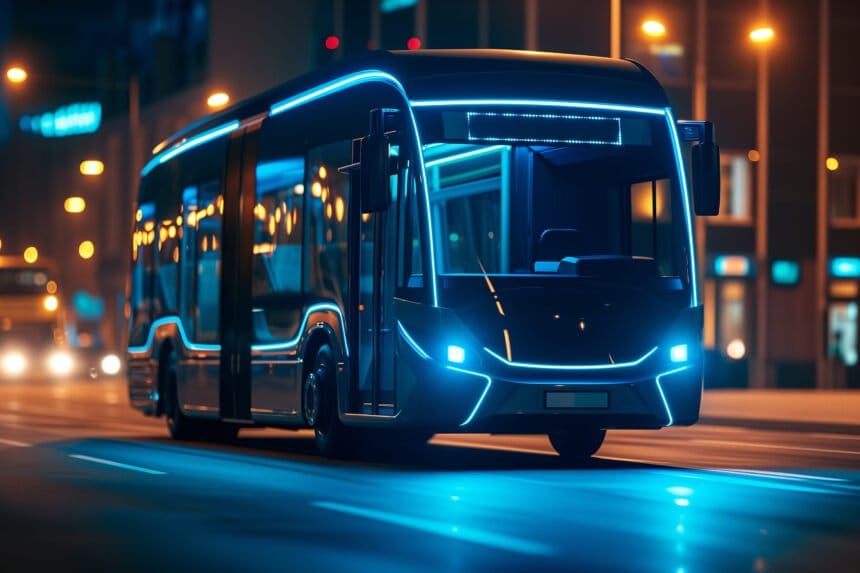AI technology has changed our lives in many important ways. One of the biggest benefits that most people haven’t talked about is its role in improving the safety of the public transportation system. We talked about how AI is changing the automotive sector, but it is helping with public transportation as well.
Precedence Research reports that the market for AI in the transportation sector was worth $3 billion in 2022 and it is growing over 22% a year. There are many reasons that AI can be helpful in improving transportation, including by helping with public safety.
This can be seen with the recent Houston Metro bus incident. AI may have prevented the problem, so we should learn more about this and how to prevent future problems like this from occurring.
AI Could Prevent a Future Bus Incident Like the One We Saw in Houston
AI can significantly contribute to the prevention of bus accidents through various means. Advanced AI algorithms can analyze vast amounts of data collected from sensors installed in buses, such as cameras, lidar, and GPS trackers, to detect potential risks in real-time. These systems can monitor driver behavior for signs of fatigue, distraction, or aggressive driving, providing immediate alerts or interventions to mitigate potential accidents. Roger Brereton talked about some of these benefits in his article on Metro Magazine.
Additionally, AI-powered predictive maintenance can identify and address mechanical issues before they lead to breakdowns or malfunctions on the road. This is one of the ways that smart cities can be safer and easier to navigate. Moreover, AI can optimize route planning and scheduling, reducing congestion and minimizing the likelihood of accidents caused by traffic jams or overcrowding. By leveraging AI technologies, bus operators can enhance safety standards, improve operational efficiency, and ultimately save lives on the road.
In the bustling city of Houston, public transportation serves as a lifeline for thousands of residents and visitors daily. Among the various modes of transit, the Houston Metro bus system stands out for its extensive network, connecting diverse neighborhoods and facilitating smooth commutes. However, the tranquility of routine travel was disrupted by a concerning incident, shedding light on the paramount importance of safety on public transportation.
Today, we delve into the details of the Houston Metro bus accident, examining its implications and the critical steps passengers can take in the aftermath.
Background Information
Houston’s Metro system, a cornerstone of the city’s public transportation infrastructure, boasts an impressive safety record. Despite the sheer volume of passengers it accommodates, incidents involving Metro buses are relatively rare, thanks to stringent safety protocols and regular maintenance checks. However, the unexpected can and does happen, as evidenced by the Houston metro bus accident today.
Details of the Accident
The incident occurred during the morning rush hour, casting a shadow over the day for many Houstonians. According to preliminary reports, the Metro bus, while navigating its designated route, was involved in a collision at a busy intersection. The exact cause of the accident is currently under investigation, but early indications suggest a complex interplay of factors, including road conditions and traffic signals.
The immediate response from emergency services was commendable, with paramedics and firefighters arriving at the scene swiftly. Their quick action ensured that those affected received prompt medical attention, highlighting the city’s preparedness for such unfortunate events.
Impact of the Accident
The accident resulted in several injuries, ranging from minor to moderate. Thankfully, there have been no reports of fatalities, but the psychological and emotional toll on the passengers and their families is undeniable. The disruption also extended to the wider community, affecting traffic flow and causing delays in Metro services across the city. Such incidents serve as a stark reminder of the fragility of our daily routines and the importance of vigilance and safety awareness.
Eyewitness Accounts
Eyewitnesses described a scene of confusion and concern immediately following the collision. Passengers aboard the bus recounted a sudden jolt, followed by a moment of panic as they sought to understand what had happened. Bystanders and local businesses quickly offered assistance, showcasing the community’s solidarity in times of crisis.
For those seeking more detailed information on the incident and its aftermath, Joe I. Zaid & Associates provides comprehensive insights and legal guidance for anyone affected by the Houston Metro bus accident.
Official Statements
In the wake of the accident, Houston Metro authorities swiftly issued a statement expressing their commitment to passenger safety and the integrity of their services. They assured the public that a thorough investigation would be conducted to ascertain the cause of the accident and to implement measures to prevent future incidents. Local government officials and public safety departments echoed this sentiment, emphasizing their dedication to maintaining a safe and reliable public transportation system for all Houstonians.
Legal and Safety Implications
The recent Metro bus accident brings to the forefront the complex legal and safety implications inherent in public transportation incidents. Under personal injury law, passengers and pedestrians involved in such accidents may have the right to seek compensation for their injuries and losses. This is particularly relevant in cases where negligence, whether on the part of the driver, the transportation authority, or another party, played a role in the incident.
It’s crucial for victims to understand their rights and the legal avenues available to them. Consulting with a knowledgeable attorney can provide clarity and guidance through the often-complicated legal process. Joe I. Zaid & Associates, a firm specializing in personal injury cases, offers expert legal assistance to those affected by public transportation accidents.
Preventive Measures and Future Safety
The recent incident underscores the ongoing need for rigorous safety measures and continuous improvement in public transportation systems. Houston Metro has a history of implementing safety protocols, including regular driver training, vehicle maintenance, and real-time monitoring of routes. However, accidents like this one highlight areas where further enhancements could be made.
Stakeholders, including local government, transportation authorities, and the community, must collaborate to explore innovative solutions to enhance safety. This could involve adopting advanced technology, improving infrastructure, and raising public awareness about safety practices.
Overview of The Incident
The Houston Metro bus accident serves as a poignant reminder of the importance of safety in our daily commutes. While the immediate focus is on recovery and investigation, the incident also prompts a broader discussion about the safety of public transportation and the measures necessary to protect passengers.
As we move forward, let us all commit to staying informed, vigilant, and proactive in advocating for a safer, more reliable public transportation system. For those directly affected by the accident, remember that resources and legal support, such as that provided by Joe I. Zaid & Associates, are available to assist you through this challenging time.
AI Could Have Prevented Houston Bus Incident
In hindsight, the tragic incident involving the Houston Metro bus underscores the urgent need for advanced AI solutions in public transportation safety. Had AI been implemented, it could have potentially detected the driver’s drowsiness or distraction, allowing for timely intervention to prevent the accident.
Furthermore, AI-driven predictive maintenance could have identified and addressed any mechanical issues beforehand, ensuring the bus was in optimal condition for operation. While we cannot change the past, this serves as a poignant reminder of the transformative potential of AI in preventing such accidents in the future. By investing in AI technologies and integrating them into public transportation systems, we can aspire to a future where incidents like the Houston Metro bus tragedy become increasingly rare, safeguarding the lives of passengers and drivers alike.







